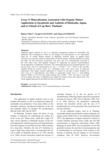Gross N Mineralization Associated with Organic Matter Application to Inceptisols and Andisols of Hokkaido, Japan, and to Ultisols of Lop Buri, Thailand
JARQ : Japan Agricultural Research Quarterly
| ISSN | 00213551 |
|---|---|
| 書誌レコードID(総合目録DB) | AA0068709X |

本文フルテキスト
jarq56-2_129-135.pdf421.83 KB
Applying organic material to soil is an important management method for sustainable crop production. We investigated its effect on soil nitrogen (N) mineralization in two experiments using the 15N isotope dilution method. In Hokkaido, Northern Japan, we applied wheat (Triticum aestivum) straw to Brown Andosol (BA; US Soil Taxonomy: Andisols) and Brown Lowland soil (BLs; US Soil Taxonomy: Inceptisols). The gross rate of N mineralization increased in BA with wheat straw and adequate inorganic N, supporting the general recommendation for the application of additional N fertilizer. The relationship between the microbial biomass N (x) and the gross rate of N mineralization (y) was y = 0.234e0.0751x (R2 = 0.815) in BA and BLs sampled during the growth season of a subsequent maize (Zea mays) crop. In long-term experiments with organic material application to Ultisols in Lop Buri, Central Thailand, the gross rates of N mineralization were higher in organically treated soil at a water-holding capacity (WHC) of 27%-41% and similar among soils at WHC ≈ 20%. The rates in Lop Buri soil were higher than those in Hokkaido soils, despite the former’s lower total carbon levels. The results suggest high specific microbial activities in Lop Buri soil.
| 刊行年月日 | |
|---|---|
| 作成者 | Rikiya NIRA Prapit SANGTONG Takao FUJIMOTO |
| 著者キーワード | maize 15N soil microbial biomass soil moisture |
| 公開者 | Japan International Research Center for Agricultural Sciences |
| 受付日 | 2020-11-26 |
| 受理日 | 2021-06-25 |
| オンライン掲載日 | |
| 巻 | 56 |
| 号 | 2 |
| 開始ページ | 129 |
| 終了ページ | 135 |
| DOI | 10.6090/jarq.56.129 |
| 言語 | eng |
